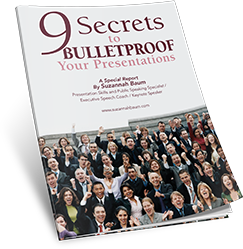How to SQUASH Nerves and Deliver a Great Lecture (my interview with Top Hat)
I’m so excited to have been interviewed by Top Hat, a teaching platform that helps professors engage students with compelling content, tools and activities.
“With class back in session, first-time profs may be feeling the pressure. An expert weighs in on how to deliver your best lecture possible, and minimize nerves in the process…”
Subjects in this very well-written article include how to prepare properly to enhance your content and delivery, how to build trust among your audience with audience-centric content, and how to squash nerves. That’s right…SQUASH them!
Read the full article on The Top Hat website, or check it out below:
Whether you’re anxious about stepping in front of a room full of students, or simply striving to give the most effective and engaging lecture, the stress can be a bit overwhelming. Luckily, there’s a lot you can do to ensure you put your best pedagogical foot forward. Here, some useful tips from Suzannah Baum, an executive speech coach, presentation skills specialist and professional speaker who has schooled McGill University students on delivering their first lectures.
Getting Ahead of Nerves
“When people tend to think about public speaking, they think of it as a very nerve-racking experience,” says Baum. She advises a two-fold approach to prevent that stomach-knotted feeling. Firstly, preparation is key. Walking in with a detailed, well laid out lesson plan is a given but first-time teachers will also want to prepare for the anxiety that might come up. “Sometimes when you’re nervous, you get a dry mouth, or your voice cracks,” says Baum. “You need a back-up plan for that, too.” Baum advises keeping a glass of water close by, which, in addition to serving a practical purpose, will give you a chance to take a moment and get centered.
Another thing you’ll want to get ahead of is technical hiccups and other distractions that may crop up. “If your slides don’t work, if you’re getting distracted by the kid in the back of the class yawning, how are you going to deal with it?” says Baum. “Having a back-up plan in your head really, really helps.”
Shifting attention towards students might also prove helpful. “When you can turn your focus to get audience-centric and audience-focused, that tends to take the pressure off you as a presenter,” Baum says.
Display Confidence
Confidence is key when it comes to effective speaking, and there’s no better way to build that self-trust than by practicing your material out loud. “The value of practice is not just to help you feel better but to practice what you’re going to say,” says Baum. “You don’t want to leave it until you’re in front of an audience to be testing out that material.” Record your lecture on audio or video to hear what your students are going to hear and iron out the kinks.
Baum also stresses the importance of arriving early. “It enhances the trust that the audience has in you,” she says. “There’s a real psychological change that happens when the students are walking in at the same time as the professor.” Once you’re standing up there, lecturers will also want to stay aware of movements, breathing and voice projection. Fidgeting, pacing and nervous speech patterns can all be a big distraction.
Keep Things in Perspective
Remember that your fears aren’t a reflection of reality. Ask yourself what’s the worst thing that can happen—you’ll be hard-pressed to identify any real danger. “Most of the time, your audience is filled with people like you and me—we don’t throw tomatoes,” says Baum. “Know that the first 30 to 60 seconds are going to be the hardest, stick it out and know that it will be okay.”
Want to learn most about being the best educator possible? Join us in Chicago for Engage 2018: The Conference for Higher Education Innovators.





